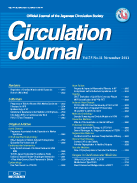Volume 75, Issue 11
Displaying 1-36 of 36 articles from this issue
- |<
- <
- 1
- >
- >|
Reviews
-
2011Volume 75Issue 11 Pages 2513-2521
Published: 2011
Released on J-STAGE: October 25, 2011
Advance online publication: October 15, 2011Download PDF (571K) -
2011Volume 75Issue 11 Pages 2522-2531
Published: 2011
Released on J-STAGE: October 25, 2011
Advance online publication: October 05, 2011Download PDF (1245K)
Editorials
-
2011Volume 75Issue 11 Pages 2532-2533
Published: 2011
Released on J-STAGE: October 25, 2011
Advance online publication: September 29, 2011Download PDF (191K) -
2011Volume 75Issue 11 Pages 2534-2536
Published: 2011
Released on J-STAGE: October 25, 2011
Advance online publication: October 05, 2011Download PDF (242K) -
2011Volume 75Issue 11 Pages 2537-2538
Published: 2011
Released on J-STAGE: October 25, 2011
Advance online publication: September 14, 2011Download PDF (186K) -
2011Volume 75Issue 11 Pages 2539-2540
Published: 2011
Released on J-STAGE: October 25, 2011
Advance online publication: October 01, 2011Download PDF (194K) -
2011Volume 75Issue 11 Pages 2541-2542
Published: 2011
Released on J-STAGE: October 25, 2011
Advance online publication: October 01, 2011Download PDF (191K) -
2011Volume 75Issue 11 Pages 2543-2544
Published: 2011
Released on J-STAGE: October 25, 2011
Advance online publication: October 01, 2011Download PDF (191K)
Original Articles
Aortic Disease
-
2011Volume 75Issue 11 Pages 2545-2551
Published: 2011
Released on J-STAGE: October 25, 2011
Advance online publication: August 04, 2011Download PDF (471K)
Arrhythmia/Electrophysiology
-
2011Volume 75Issue 11 Pages 2552-2558
Published: 2011
Released on J-STAGE: October 25, 2011
Advance online publication: September 14, 2011Download PDF (475K) -
2011Volume 75Issue 11 Pages 2559-2565
Published: 2011
Released on J-STAGE: October 25, 2011
Advance online publication: August 26, 2011Download PDF (574K)
Cardiovascular Intervention
-
2011Volume 75Issue 11 Pages 2566-2572
Published: 2011
Released on J-STAGE: October 25, 2011
Advance online publication: August 09, 2011Download PDF (1190K) -
2011Volume 75Issue 11 Pages 2573-2580
Published: 2011
Released on J-STAGE: October 25, 2011
Advance online publication: August 06, 2011Download PDF (857K) -
2011Volume 75Issue 11 Pages 2581-2589
Published: 2011
Released on J-STAGE: October 25, 2011
Advance online publication: August 20, 2011Download PDF (1640K) -
2011Volume 75Issue 11 Pages 2590-2597
Published: 2011
Released on J-STAGE: October 25, 2011
Advance online publication: September 14, 2011Download PDF (289K)
Epidemiology
-
2011Volume 75Issue 11 Pages 2598-2604
Published: 2011
Released on J-STAGE: October 25, 2011
Advance online publication: August 20, 2011Download PDF (1248K)
Heart Failure
-
2011Volume 75Issue 11 Pages 2605-2613
Published: 2011
Released on J-STAGE: October 25, 2011
Advance online publication: August 06, 2011Download PDF (1924K) -
2011Volume 75Issue 11 Pages 2614-2620
Published: 2011
Released on J-STAGE: October 25, 2011
Advance online publication: September 02, 2011Download PDF (334K)
Imaging
-
2011Volume 75Issue 11 Pages 2621-2627
Published: 2011
Released on J-STAGE: October 25, 2011
Advance online publication: August 06, 2011Download PDF (553K) -
2011Volume 75Issue 11 Pages 2628-2634
Published: 2011
Released on J-STAGE: October 25, 2011
Advance online publication: August 27, 2011Download PDF (1051K)
Ischemic Heart Disease
-
2011Volume 75Issue 11 Pages 2635-2641
Published: 2011
Released on J-STAGE: October 25, 2011
Advance online publication: August 09, 2011Download PDF (1122K) -
2011Volume 75Issue 11 Pages 2642-2647
Published: 2011
Released on J-STAGE: October 25, 2011
Advance online publication: August 11, 2011Download PDF (327K) -
2011Volume 75Issue 11 Pages 2648-2653
Published: 2011
Released on J-STAGE: October 25, 2011
Advance online publication: September 03, 2011Download PDF (426K)
Molecular Cardiology
-
2011Volume 75Issue 11 Pages 2654-2659
Published: 2011
Released on J-STAGE: October 25, 2011
Advance online publication: July 29, 2011Download PDF (288K)
Preventive Medicine
-
2011Volume 75Issue 11 Pages 2660-2667
Published: 2011
Released on J-STAGE: October 25, 2011
Advance online publication: August 20, 2011Download PDF (1504K)
Pulmonary Circulation
-
2011Volume 75Issue 11 Pages 2668-2674
Published: 2011
Released on J-STAGE: October 25, 2011
Advance online publication: August 27, 2011Download PDF (1172K) -
2011Volume 75Issue 11 Pages 2675-2682
Published: 2011
Released on J-STAGE: October 25, 2011
Advance online publication: September 02, 2011Download PDF (1424K)
Regenerative Medicine
-
2011Volume 75Issue 11 Pages 2683-2691
Published: 2011
Released on J-STAGE: October 25, 2011
Advance online publication: August 09, 2011Download PDF (1212K)
Valvular Heart Disease
-
2011Volume 75Issue 11 Pages 2692-2698
Published: 2011
Released on J-STAGE: October 25, 2011
Advance online publication: August 20, 2011Download PDF (704K) -
2011Volume 75Issue 11 Pages 2699-2704
Published: 2011
Released on J-STAGE: October 25, 2011
Advance online publication: September 01, 2011Download PDF (433K)
Vascular Medicine
-
2011Volume 75Issue 11 Pages 2705-2710
Published: 2011
Released on J-STAGE: October 25, 2011
Advance online publication: July 28, 2011Download PDF (1516K)
Images in Cardiovascular Medicine
-
2011Volume 75Issue 11 Pages 2711-2713
Published: 2011
Released on J-STAGE: October 25, 2011
Advance online publication: July 29, 2011Download PDF (597K) -
2011Volume 75Issue 11 Pages 2714-2715
Published: 2011
Released on J-STAGE: October 25, 2011
Advance online publication: July 29, 2011Download PDF (469K) -
2011Volume 75Issue 11 Pages 2716-2717
Published: 2011
Released on J-STAGE: October 25, 2011
Advance online publication: July 29, 2011Download PDF (308K)
-
2011Volume 75Issue 11 Pages Cover11
Published: 2011
Released on J-STAGE: October 25, 2011
Download PDF (666K) -
2011Volume 75Issue 11 Pages Content11
Published: 2011
Released on J-STAGE: October 25, 2011
Download PDF (178K)
- |<
- <
- 1
- >
- >|
